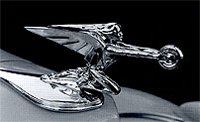Lincoln MIA
Once upon a time there was a luxury car manufacturer in America. The company virtually owned the luxury car business, both at home and abroad. Their cars were the gold standard for expensive cars, and rich and powerful people the world over bought and used them. They easily sold more luxury cars in America than most of their competitors combined. Their reputation for engineering innovation and excellence was unsurpassed. All of the best custom body builders clamored to make special show cars for them, in hopes that they could make it into the sales catalogue this company published every December.
Then came hard times. The stock market bubble popped. Thousands of people lost their jobs. And, the market for luxury cars started to dwindle. To make matters worse, the company's major competitor in America started to build bigger and more luxurious cars, and developed a reputation as a true engineering innovator in their own right.
Top managers, many of whom had been with the company for decades, agonized about what they should do. To do nothing was to ensure that the company would spend all of their savings and go out of business in a few years. The answer, they decided, was to build a car that would sell for substantially less than their traditional luxury models. Thus was born the Packard 120, in 1936.
The 120 was, by all accounts, a pretty nice car. It was powered by a smooth straight 8 engine, and it carried the traditional Packard grill and radiator ornament proudly. But it was no custom built luxury car, just a mass-produced, medium priced vehicle, a Packard one could buy for the price of an Oldsmobile or a Buick. The sales success of the 120 saved the day for Packard, and the company managed to stay in business for another couple of decades. The underpinnings of the 120 provided the basis for many Packard models, like the Clipper and the infamous bathtub Packards of the early 50s.
But the day that ordinary people could afford a Packard marked the end of the company as a viable luxury car manufacturer. Packard's demise as America's luxury car was guaranteed when the town's richest banker glanced out the window of his chauffeur-driven Packard as he left the estate, only to see his gardener arriving in a Packard. In just a few years, Cadillac overtook Packard in luxury car sales, and wrested the crown of American luxury away from Packard for good.
Fast-forward 60 years, to the 2005 North American International Auto Show, in Detroit. Lincoln, reeling from a 50% drop in sales over the last 5 years, announced the new Lincoln Zephyr. Priced to compete with the Nissan Maxima and the Toyota Avalon, the Zephyr is the lowest priced Lincoln (inflation adjusted) ever offered. While the Zephyr appears to be a very nice medium priced car (it is, after all, made from a Mazda 6) it faces some pretty tough competition. The Zephyr, like the Packard 120, will allow thousands of new owners to sail down the road behind a Lincoln grill and hood ornament. If it sells well, Lincoln will make some money, but at what cost to the Lincoln brand? Will the average hip-hop artist still want a Lincoln Navigator when he sees the bartender at his favorite club drive up in a Lincoln Zephyr?
Lincoln's Town Car is already suffering under the onslaught of a revitalized Cadillac and a host of other tough luxury car competitors. Once the car of choice for stretch limo converters, it is rapidly being displaced by the new Cadillac DTS. The Lincoln LS, aimed at the BMW 3 series, is failing, despite offering a V8 to the 3 series 6. The Navigator is in a fierce sales duel with SUVs from Porsche (Porsche!), BMW, Lexus, Land Rover, Cadillac and others, and the Aviator appears never to have lifted off the runway. Moving the Lincoln brand downscale threatens the viability of these products even more.
It is rare that a luxury carmaker recovers from flirting with downscale products. Packard never recovered, and Cadillac, after the unfortunate Cimarron and Catera, discovered that it takes many years and many billions of dollars in new products, to begin to turn around a cheapened image. Jaguar is in the process of discovering this, in the wake of the X-type debacle. Even Infiniti found that cheapening the brand caused it to lose all value in the US.
Ironically, the first Zephyr, in 1936, was Lincoln's answer to the Packard 120 and the LaSalle. It didn't carry the Lincoln name, just as LaSalle didn't carry the Cadillac name. The value of the Lincoln name wasn't squandered on a medium priced car, and lived on in the first Lincoln Continental, and a host of other fine cars.
More by Bob Elton
Latest Car Reviews
Read moreLatest Product Reviews
Read moreRecent Comments
- Spectator Wild to me the US sent like $100B overseas for other peoples wars while we clammer over .1% of that money being used to promote EVs in our country.
- Spectator got a pic of that 27 inch screen? That sounds massive!
- MaintenanceCosts "And with ANY car, always budget for maintenance."The question is whether you have to budget a thousand bucks (or euro) a year, or a quarter of your income.
- FreedMike The NASCAR race was a dandy. That finish…
- EBFlex It’s ironic that the typical low IQ big government simps are all over this yet we’re completely silent when oil companies took massive losses during Covid. Funny how that’s fine but profits aren’t. These people have no idea how business works.






































Comments
Join the conversation
This made no sense then as the Zephyr even less now as the MK whatever. To let the LS die from neglect like every decent product in recent memory is ridiclous. Too bad they didn't make the concept from 2002 a reality.